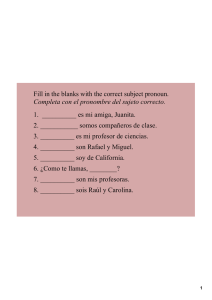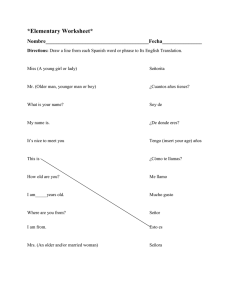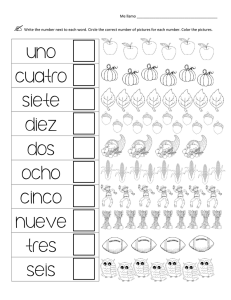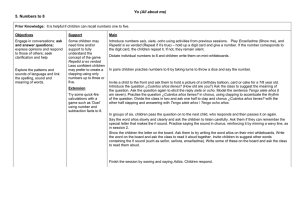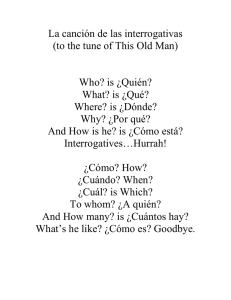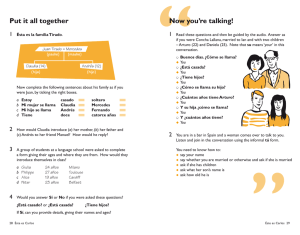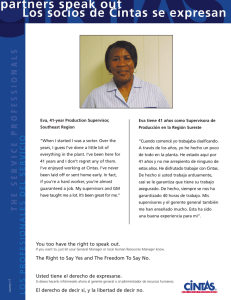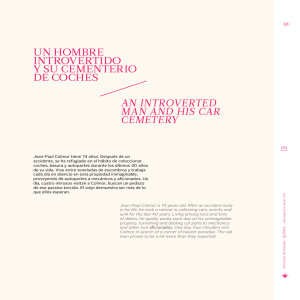Yo(All about me) 6. This is me! - Association for Language Learning
Anuncio
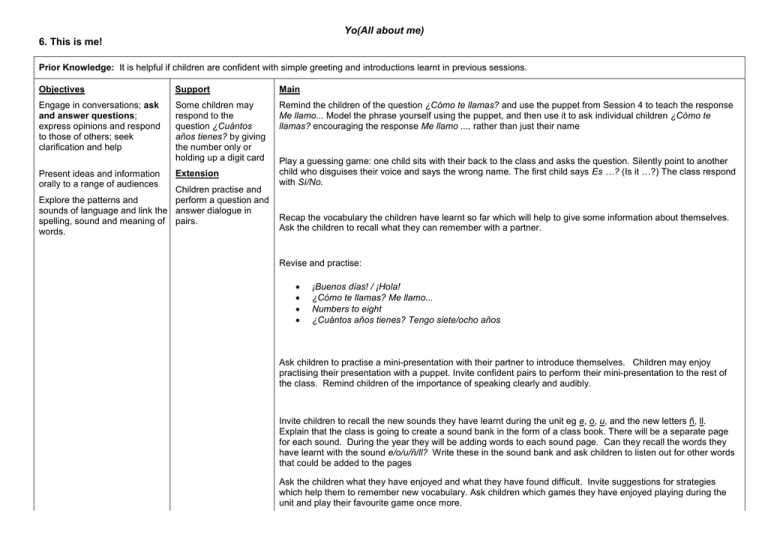
Yo(All about me) 6. This is me! Prior Knowledge: It is helpful if children are confident with simple greeting and introductions learnt in previous sessions. Objectives Support Main Engage in conversations; ask and answer questions; express opinions and respond to those of others; seek clarification and help Some children may respond to the question ¿Cuántos años tienes? by giving the number only or holding up a digit card Remind the children of the question ¿Cómo te llamas? and use the puppet from Session 4 to teach the response Me llamo... Model the phrase yourself using the puppet, and then use it to ask individual children ¿Cómo te llamas? encouraging the response Me llamo ..., rather than just their name Present ideas and information orally to a range of audiences Extension Children practise and Explore the patterns and perform a question and sounds of language and link the answer dialogue in spelling, sound and meaning of pairs. words. Play a guessing game: one child sits with their back to the class and asks the question. Silently point to another child who disguises their voice and says the wrong name. The first child says Es …? (Is it …?) The class respond with Sí/No. Recap the vocabulary the children have learnt so far which will help to give some information about themselves. Ask the children to recall what they can remember with a partner. Revise and practise: ¡Buenos días! / ¡Hola! ¿Cómo te llamas? Me llamo... Numbers to eight ¿Cuántos años tienes? Tengo siete/ocho años Ask children to practise a mini-presentation with their partner to introduce themselves. Children may enjoy practising their presentation with a puppet. Invite confident pairs to perform their mini-presentation to the rest of the class. Remind children of the importance of speaking clearly and audibly. Invite children to recall the new sounds they have learnt during the unit eg e, o, u, and the new letters ñ, ll. Explain that the class is going to create a sound bank in the form of a class book. There will be a separate page for each sound. During the year they will be adding words to each sound page. Can they recall the words they have learnt with the sound e/o/u/ñ/ll? Write these in the sound bank and ask children to listen out for other words that could be added to the pages Ask the children what they have enjoyed and what they have found difficult. Invite suggestions for strategies which help them to remember new vocabulary. Ask children which games they have enjoyed playing during the unit and play their favourite game once more. Yo(All about me) 6. This is me! Finish the session by waving and saying Adiós. Children respond. Grammar Grammar Phonics focus Phonics focus For teachers: For children For teachers: For children: The phrase “It is…: in English is translated as just one word in Spanish “Es”. This is because Spanish does not always use the personal pronouns (I, you, etc). “Es” literally means ‘”is”. No specific focus No specific focus Revision of e/o/u/ñ/ll Yo(All about me) 6. This is me! Learning Outcomes New National Curriculum Links Children can: English hold a short conversation, introducing themselves and finding out about somebody else give a short oral presentation with a partner identify a range of different sounds used in Spanish Throughout the week: Spoken Language – Key Stage 1 and 2 Teachers should ensure the continual development of pupils’ confidence and competence in spoken language. Resources Practise asking and answering the question ¿Cuántos años tienes? eg at registe, lining-up time. The class could time themselves to see how long it takes them to get right round the class with each person responding to and then asking the next person ¿Cuántos años tienes? Puppets Sound bank class book Computer Interactive whiteboard Multimedia presentation Teaching Tips Do a Mexican wave to practise saying ages Pupils can try acting out their dialogues using funny voices, in the style of different emoticons, or in the manner of different adjectives El lenguaje del profesor / de la profesora ¡Buenos días! ¡Hola! ¿Qué tal? Señor/ Señora/ Señorita Sí/No Me llamo ¿Cómo te llamas? Es….? ¿Cuántos años tienes? Tengo siete/ocho años ¡Genial, estupendo, muy bien! Teacher’s Language Good morning! Hello! How are you? Sir/Madam, Mr/Mrs/Miss yes/no My name is What’s your name? Is it …? How old are you? I’m seven/eight years old Super, great, very good! El lenguaje de los niños ¡Buenos días! ¡Hola! ¡Adiós ! Señor/ Señora/ Señorita Sí/No Me llamo ¿Cómo te llamas? Es….? ¿Cuántos años tienes? Tengo siete/ocho años Children’s Language Good morning! Hello! Goodbye! Sir/Madam, Mr/Mrs/Miss yes/no My name is What’s your name? Is it …? How old are you? I’m seven/eight years old Yo(All about me) 6. This is me! Silencio por favor Escuchad/Escucha Venid/Ven aquí Repetid/Repite Quiet please Listen (plural/singular) Come here (plural/singular) Repeat (plural/singular) End of Unit activities Learning Objectives to apply the knowledge, skills and understanding in this unit Teaching Activities Using a model, children write a short text based on their mini-presentation to accompany their portrait for a class display. If the school has a Spanish-speaking partner school, the information can be shared through e-mail or posted. Learning Outcomes use Spanish for real purposes to introduce themselves in oral and written form Points to note Children can use hand-held video cameras to record each other making short presentations. These may be incorporated into a presentation or edited to make a short film. Using a learning platform, these may be saved and possibly shared with a partner school. The web-site Global Gateway provides opportunities for finding partner schools abroad: www.globalgateway.org
